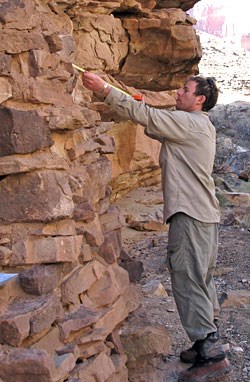NPS Archeology "Blitz Trip" Visits Archeological Sites along the Colorado River Corridorby Allyson Mathis 
Monitoring archeological sites is necessary to determine if the sites have been impacted by erosion due to sediment depletion in the Colorado River system from the operation of Glen Canyon Dam and by visitation by river runners and hikers. Most of the sites were in good condition having only minor impacts from erosion and/or visitation. The crew also monitored sites that were excavated by MNA and the NPS in a joint project between 2007 and 2009, assessed erosion control features such as check dams at sites that have been impacted by significant erosion, and improved documentation of a number of sites. 
Since the implementation of the Colorado River Management Plan (CRMP) in 2006, many of the 600 sites in the CRMP project area have been visited by park archeologists during the integrated resource monitoring trips. The purpose of the “archeology blitz” monitoring trip in February was to allow crews to focus on archeological site assessments and to complete some more intensive projects than CRMP monitoring protocols allow. For example, crews were able to examine a number of archeological sites in side canyons that may have an increase in recreational use during the winter months with more winter launches under the CRMP. 
The National Park Service and the Zuni Conservation Team built rock and brush check dams to control erosion at these sites in the 1990s. Check dams limit erosion by reducing water velocity in washes and arroyos and trapping sediment. River corridor archeologist Jen Dierker explained, “Regular maintenance of check dams is an integral part of erosion control work at archeological sites along the Colorado River. Watch check dam video clip. On the trip, we were joined by Utah State University geomorphologist Christopher Tressler. Almost all the check dams we evaluated were in good shape. We had to repair only three check dams and construct one new one. It seems like check dams are the most appropriate erosion control method for use along the river, and that other more aggressive methods don’t work as well in this environment.” 
Unkar Delta was a thriving ancestral Puebloan farming community between 800 and 1000 years ago. Some sites at Unkar Delta were excavated in the late 1960s by the School of American Research. Today, visiting Unkar Delta is a highlight for many river trip passengers as they travel through Grand Canyon. River runners can view the foundations of many structures and see artifacts such as pot sherds at the site. 

Another accomplishment during the trip was locating two archeological sites in Surprise Valley that had only been documented by helicopter survey in the 1960s. Dierker said, “The only documentation we had of these sites were photographs taken from a helicopter hovering above them and a short description of each one. 
As a follow up to the excavation of nine archeological sites by MNA and the NPS between 2007 and 2009, the crew visited the sites to assess the effectiveness of stabilization measures taken at the conclusion of each dig. 
Jane Rodgers, Deputy Chief, Socio-Cultural Resources, added, “I am really proud of our staff’s capability and creativity to bring together partnership trips such as this. We brought together specialists in both archeology and river running to carry out the blitz. |
Last updated: February 24, 2015
